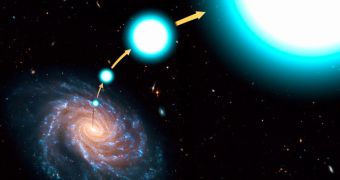Experts at the American space agency announce that recent data from the Hubble Space Telescope seem to indicate that a runaway star has been ejected from the Milky Way. The celestial object moves at speeds up to three times that of the Sun, which makes it a part of the hypervelocity star class. Observing such a phenomenon is an extremely rare occurrence, astronomers at NASA say, adding that the object itself must be around a hundred million years old or so. More interesting than the star's speed is way in which astrophysicists believe it formed.
According to current theories, all those years ago a triple star system was wandering through the central regions of our galaxy. As it did so, it came too close to the supermassive black hole that lies at the core of the Milky Way. When this happened, the dark behemoth captured two of the stars, and then sent them hurtling out of their home. The celestial bodies united into a single, blue star, featuring incredibly hot surface temperatures, and impressive speeds. The resulting object has been dubbed HE 0437-5439, astronomers reports. They admit that the story may seem outlandish, but nevertheless argue that this is the most likely scenario they have about what happened.
“Using Hubble, we can for the first time trace back to where the star came from by measuring the star's direction of motion on the sky. Our measurements point directly to the Milky Way center,” says Warren Brown, who is an astronomer at the Cambridge, Massachusetts-based Harvard-Smithsonian Center for Astrophysics (CfA). The expert is also a member of the international team of scientists that used Hubble to make the remarkable findings. Brown is the author of a paper showcasing the star, which appeared in the July 20 online issue of the esteemed publication Astrophysical Journal Letters.
“These exiled stars are rare in the Milky Way's population of 100 billion stars. For every 100 million stars in the galaxy, there lurks one hypervelocity star,” Brown explains, adding that HE 0437-5439 is currently some 200,000 light-years away from the black hole that kicked it out, in the outer fringes of the Milky Way. “Studying these stars could provide more clues about the nature of some of the Universe's unseen mass, and it could help astronomers better understand how galaxies form,” University of Michigan in Ann Arbor team leader Oleg Gnedin concludes.

 14 DAY TRIAL //
14 DAY TRIAL //